After 70 Years
by Sachi Sri Kantha, July 7, 2024
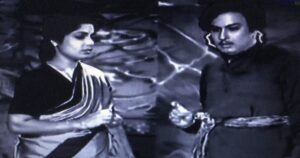
Screen grab of a ‘Malai Kallan’ scene. MGR (rt) with Sandhya (mother of Jayalalitha)
70 years ago, on July 22, 1954, the trend-setting Malai Kallan (Mountain Dacoit) Tamil movie, with M.G. Ramachandran (MGR) and P. Bhanumathi in the lead roles was released in Tamil Nadu to great acclaim by the public. Its political and social relevance was realized 23 years later in the mid-1977 Tamil Nadu Assembly elections when MGR was popularly elected as the Chief Minister of Tamil Nadu for the first time, replacing M. Karunanidhi – the multi-talented Tamil author. The script writer of Malai Kallan movie was none other than M. Karunanidhi, a rising leader of the DMK party, who became the 2nd DMK party chief minister in 1969. When this movie was released, MGR was 37, and Karunanidhi was 30.
Introduction
First, ‘Malai Kallan’ movie originated from the Tamil novel by the same name published by Namakkal V. Ramalingam Pillai (aka, Namakkal Kavignar, 1888-1972). He was a freedom fighter, and had sympathies with the Congress Party. Primarily he was a Tamil poet, and was nominated as the first Poet laureate of the Madras Presidency (which then incorporated Telugu speaking regions as well). As such, ‘Malai Kallan’ movie was produced by S,M. Sriramulu Naidu (1910-1976) simultaneously in Tamil and Telugu versions and released simultaneously. Akin to the MGM’s ‘Wizard of Oz’ movie of 1939, based on Frank Baum’s book ‘The Wonderful Wizard of Oz’ (1900) – a political fantasy masked as a children story, ‘Malai Kallan’ was a mild political fantasy story (based on Robin Hood legend of English folklore) set in Indian cultural milieu. Another similarity: like the ‘Somewhere Over the Rainbow’ song sung by Judy Garland, ‘Ethanai Kaalam Thaan Emaruvar’ song in Tamil sung by T.M. Soundararajan catapulted this movie’s popularity beyond generations.
Secondly, quite a number of deception and untruths are being spread in printed books and in digital media, about the Malai Kallan movie, by partisan authors, fans and bloggers. I’d say, it began with the 1992 tract on MGR by sociologist M.S. S. Pandian (1958-2014). Pandian’s poor fact checking skills may be excused, because in 1992, to watch ‘Malai Kallan’ movie, either one needs to go to a movie theater that screened old movies, or have some connection to the movie industry to watch the film version. Writer and commentator Vaasanthi (b. 1941) deserves my scorn for simply copying the errors of Pandian verbatim, in her own 2006 book, ‘Cut-Outs, Caste and Cine Stars’. In 2006, with digitalized versions appearing in Youtube social media, a diligent writer can fact check, from one’s computer screen. I presume Vaasanthi was not up to this grade! Even aging actor Rajanikanth, who followed MGR’s steps in the Tamil movies, also had contributed to such deception (see below). In this 70th anniversary commemorative essay, I’ll tackle some aspects of these twisted tale telling.
Thirdly, there has been more than one translation of the Tamil phrase ‘Malai Kallan’, the novel by Ramalingam Pillai, published in 1942. Malai = Mountain or hill, Kallan = thief. Thus, simply it could be translated as ‘The Mountain Thief’ (which I had used previously, in my MGR Remembered series) or ‘The Bandit from the Mountains’. Now, I prefer the phrase ‘Mountain Dacoit’, as there is a subtle difference between ‘thief’ and ‘dacoit’. The dictionary defines the word ‘thief’ as ‘one who steals especially secretly and without violence’. The word ‘dacoit’ is of Hindi origin (dakait, daka = gang robbery) relates to a member of Indian or Burmese armed robber band. Thus, violence is implied in the act of a dacoit. As such, ‘Mountain Dacoit’ seems preferable than ‘Mountain Thief’.
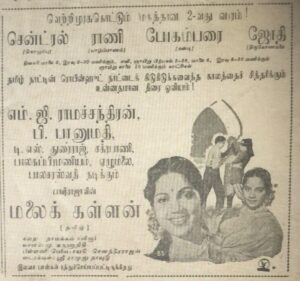
Malai Kallan movie advertisement in Sutantiran of Oct 10, 1954
Here I provide a copy of this movie’s Tamil advertisement as it appeared in Sutanthiran weekly of Oct. 10, 1954 in Colombo. This newspaper was owned by S.J.V. Chelvanayakam, the leader of Federal Party. The descriptive details in the advertisement reads as follows, providing the details of the theaters, actors and other artistes involved:
“A Triumphant 2nd Week-
Central (Colombo), Rani (Jaffna), Bogambarai (Kandy), Jothi (Trincomalee)
The Robin Hood story of Tamil Nadu that offers historical thrill in the movie screen.
M.G. Ramachandran, P. Bhanumathi, T.S. Durairaj, Chakrapani, Balasubramaniam, Ezhumalai, Balasaraswathi acted,
MALAI KALLAN (Tamil)
Story: Namakal Poet
Script: M. Karunanidhi
Back Music: Periyanayagi, Soundararajan
Direction: Sri Ramulu Naidu”
The second line above indicates that the movie was released simultaneously in four theaters located in Colombo, Jaffna, Kandy and Trincomalee. Additional sociological vignettes deduced from the advertisement are,
- The movie was released in Ceylon, in the first week of October 1954, after two months of it’s release in Chennai.
- Show time during the weekdays was 6:00 and 9:30 pm; weekends Sat and Sun had a 2:30 pm show. Sunday had a 10:00 am show.
- In the listing of lead actors, the names of villains were excluded! Maybe those featured (Sriram and E.R. Sahadevan) were below the recognition level of the audience!
- ‘Free Passes’ have been suspended.
Sriramulu Naidu
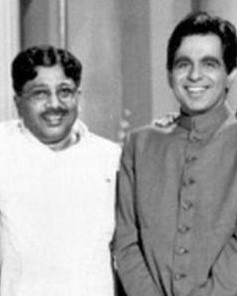
Sriramulu Naidu (lt) and Dilip Kumar (rt)
The producer of Malai Kallan movie Sriramulu Naidu, was one the two founders of Pakshiraja Movies, based in Coimbatore. He belonged to the generation of pioneer group of studio owners who produced and directed their own movies. In India, this clique included Gemini S.S. Vasan (1903-1969), A.V.M. Meiyappa Chettiar (1907-1979), T.R. Sundaram (1907-1963) of Modern Theatres and M. Somasundaram (1907? – 1960) of Jupiter Pictures. Though they might have been blessed with a degree of creative sensibility, their primary focus was entertainment of illiterate masses with dance-song sequences, with an eye on box office till.
About how, Sriramulu Naidu came to contract MGR to star in this movie, has been described by MGR in his autobiography. This was presented earlier in my MGR Remembered series – Part 71 [MGR had stated that it was on the request made by Lena Chettiar of Krishna Pictures, he agreed to star, mainly because Sriramulu Naidu was a well-recognized producer in Indian movie circle of that era. [https://sangam.org/mgr-remembered-part-71/]
For reasons known only to them, in their brief history ‘Indian Film’ (1963), Erik Barnouw and S. Krishnaswamy had obliterated Malai Kallan’s critical and financial success, in preference to it’s Hindi version ‘Azaad’ starring Dilip Kumar (1922-2021) and Meena Kumari (1933-1972), as follows:
“Pakshiraja Studio in Coimbatore – in 1955 the great Dilip Kumar and Meena Kumari, both approaching top starring rank, flew south to make Azaad (Azaad), the story of a mountain bandit’. The film grossed Rs 8,000,000 in its Hindi version, and additional millions in other versions.”
On the casting in the Tamil and Telugu versions
An immediate impression was that, casting was economical. Established villains of MGR movies (such as M.N. Nambiar or P.S. Veerappa) were excluded, in preference to Sriram and E.R. Sahadevan. In fact, Sriram had played the hero role in Sriramulu Naidu’s previous production ‘Ponni’ (1953) movie. A potential reason for using Sriram (in preference to Nambiar or Veerappa) was he could play the chief villain role in both Tamil and Telugu versions.
Among the women artistes, only three recognized names were featured. P. Bhanumathi (1925-2005) as the heroine, Sandhya (1924-1971, the mother of Jayalalitha) was the second heroine, and Pollachi S. Gnanam (1921-1961) as the senior mother/aunt figure. The last named P.S. Gnanam was a versatile character artiste recognized in her villain roles, who died prematurely in a car accident at the age of 41. In addition to performing in two dance sequences, dancers Sayee and Subbulakshmi also acted in minor roles. Among the male artistes, MGR’s elder sibling M.G. Chakrapani was cast as sub Inspector Arumugam, and his side kick was comedian T.S. Durairaj as Head constable #441. Comedy track was the weakest in the story plot, barring one liners from Durairaj as responses to sub Inspector’s queries. Another comedian V.S. Ezhumalai, played the house servant role. Devoid of a female comedian in the casting, nothing noticeable linger in memory.
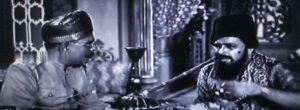
Screen grab of a ‘Malai Kallain ‘scene. MGR (rt) as Abdul Rahim with his elder sibling Chakrapani (lt), as a sub Inspector
For the Telugu version, while Bhanumathi played the similar heroine role as in the Tamil version, N.T. Rama Rao (1923-1996) played MGR’s role. Like Bhanumathi, other artistes (D. Balasubramaniam, Sriram, Surabhi Balasaraswathi, Sandhya, as well as Sayee and Subbulakshmi dance duo) played the same roles in the Telugu version also. The sub Inspector role and Head constable #441 played by M.G. Chakrapani and T.S. Durairaj in Tamil were enacted by Mukkamala Krishnamurthy and Relangi Venkata Ramayya respectively.
The entry on ‘Malai Kallan’ in the Encyclopedia of Indian Cinema
Though it’s riddled with noticeable factual errors, for record, I provide below the entry on ‘Malai Kallan’ movie, in the Encyclopedia of Indian Cinema (1998) verbatim, No entries exist for the five language variants (Telugu, Hindi, Kannada, Malayalam and Sinhala) of this movie.
MalaiKallan
1954, 186 min, black and white, Tamil.
Direction/script S.M.Sreeramulu Naidu, production company Pakshiraja Studio
Story/co-lyricist Namakkal Kavignar
Dialogue M. Karunanidhi
Co-lyricist Balasubramanyam, Bharatidasan, Thanjai Ramaiyadas, Makkalanban
Music S.M. Subbiah Naidu
Cinematography Sailen Bose
Lead players M.G. Ramachandran, P. Bhanumathi, M.G. Chakrapani, P.S. Gnanam, T.S. Dorairaj, Surabhi Balasaraswathi, , Ezhumalai, Balasubramnayam, Sandhya, E.R. Sahadevan, Santha, Sriram
Classic MGR movie about an outlaw Kumaraveeran, who robs the rich to feed the poor while maintaining a double identity as the Muslim merchant Abdul Rahim. He falls in love with Poonkothai (Bhanumathi) who is later used by the police to entrap the hero. Eventually, the police officer turns out to be the bandit’s brother. According to M.S.S. Pandian (1992), in this film MGR established his political persona as a ‘superman’ imposing his own version of justice. The Karunanidhi script, replete with the customary DMK propaganda, inaugurated the crucial device of hinging its political message in a song. Pandian translates its lines as follows: ‘How long will they fool us/ in this land of ours?/ We’ll open schools in every street/ and see that none is unlettered/ We’ll teach many vocations/ and banish starvation/ Because they don’t even get a glimpse/ of the hoarded money/ Why do they keep yelling/ There is no god?/ Because He has not shown Himself/ for far too long’. Written by Bharatidasan and sung by T.M. Soundararajan, the song was very popular. Malaikallan was remade in Hindi by the same studio as Azaad (1955; Free) starring Dilip Kumar.”
As M.S.S. Pandian was an acknowledged consultant to this Encyclopedia project, he had to be blamed for errors and deception in the above details, by inserting his crude English translation, with few non-existent lines in MGR’s message song! Here are the noted errors, in this entry.
First, poet Bharatidasan was NOT involved in this movie. He was NOT a lyricist.
Secondly, The political message song ‘Eththanai Kaalam thaan emaruvar’ was written by Tanjai Ramaiah Das AND Kovai A. Ayyamuthu. (see below).
Thirdly, Lines describing atheism in this song don’t appear in the lyrics sung by Soundararajan, at all. (see below). The lines ‘Why do they keep yelling ‘There is no god?/ Because He has not shown Himself/ for far too long’ appears in another song by P.A. Periyanayagi for a gypsy dance sequence of Saee- Subbulakshmi. And MGR was NOT featured in this dance sequence.
Fourthly, Sriramulu Naidu, produced this movie simultaneously in Tamil with MGR, and in Telugu with N.T. Ramarao. The Tamil version released on July 22, 1954 and Telugu version released on Aug. 5, 1954. Heroine Bhanumathi played the same role in both versions, and S.M. Subbiah Naidu (1914-1979) was the tune smith for both Tamil and Telugu versions. Apart from this main work, Subbiah Naidu also acted in a marginal role as a native doctor in the Tamil version.
The Hindi version tagged as Azaad (Free) was released in July 1, 1955. For this version, the tune smith was Chitalkar Ramchandra (1918-1982). Following box office success in all these three language versions, Sriramulu Naidu produced three re-make versions in Kannada (with Kalyana Kumar and Mynavathi), in Malayalam (with Satyan and Ragini) and in Sinhala (with Herbi Seneviratne and Kanthi Gunatunga) and released these in 1957.
Paradigm shifting message sequence in the Tamil Movie
What I consider as the historically (political and social) relevant paradigm-shifting segment in the movie, was a song-sequence (lasting for only 2 min and 45 sec) in which MGR was walking in a hill range, escorting heroine Bhanumathi in a white horse back, and lip-synching an ideology-promotion song, recorded with T.M. Soundararajan. This was the first for MGR – Soundararajan combination that would last for next 24 years, until the end of MGR’s movie career.
Ethanai kaalam thaan emaruvaar – Malaikallan (1954), T.M. Soundararajan – solo song
Actors: MGR, along with Bhanumathi
Lyrics: Tanjai Ramiah Das and Kovai A. Ayyamuthu
The Youtube clip: https://www.youtube.com/watch?v=iqgKO8RGY8o
About the lyrics composition of this wonderful song, historical facts indicate some interesting twists. It was a combined effort of two lyricists, and NOT one. More than one source I had checked informs, that the initial stanza (what is called ‘pallavi’ in Carnatic music lingo) was written by Tanjai Ramiah Das (1914-1965). But the rest of the lyrics (anupallavi and saranam stanzas) were completed by Kovai Angannan Ayyamuthu (1898-1975). Though the script writer Karunanidhi and MGR then belonged to the DMK party, these two lyricists were NOT affiliated to DMK. Particularly Kovai Ayyamuthu had a reputation as a Tamil Nadu freedom fighter, and more associated with the then Congress Party.
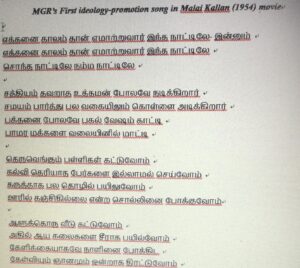
Lyrics of MGR’s ideology-promotion song in ‘Malai Kallan’ (1954) movie
The original Tamil lyric is presented nearby in a photo figure. What is noticeable in composition is that, Pallavi and Anupallavi sections are directed at the deeds of ‘them’ (Oppressors). Two saranam sections are directed on what ‘we’ (Oppressed) will be aiming at. It’s English translation is as follows:
Pallavi
For how long will they be fooling us?
In this land? Native land? Our land?
Anupallavi
They act like one who is virtuous
Yet swindle [us] many ways in deeds
While garbing like a daytime devotee
Poor folks trapped in net deeply
Saranam 1
We’ll build schools in each street
And see to that illiteracy falls to zero
We’ll teach numerous work skills
‘Nothing to eat’ word will disappear so
Saranam 2
We’ll build houses for every one
Fine arts to be learned there with polish
To enjoy lively each passing day
Information and knowledge we’ll pursue
Pon Sellamuthu, the editor of Tanjai Ramaiah Das compendium of movie lyrics, had informed the history behind the composition of this lyric. To quote, ‘lyricist [Ramaiah Das] began the pallavi ‘Ethanai Kaalam Thaan Emaruvar Intha Naatile’, but couldn’t complete it. The reason was, he had to return urgently for the inauguration function of his newly built house. Though MGR had recommended him for composition, due to urgent circumstances, he couldn’t complete it. Therefore, the lyric was subsequently completed by poet Kovai Ayyahmuthu.’ Movie music historian Vamanan also confirms this story with the addition, that it was Subbiah Naidu, the tune smith, who arranged for freedom fighter Ayyahmuthu, to complete the lyrics, with anupallavi and saranam stanzas. Vamanan also notes that to sing this lyric, it was Subbaiah Naidu who chose Soundararajan and it became the first ideology-promotion song for MGR. It also captured the attention of the masses due to its meaningful lines set in folk tune mold with violin and percussion instruments. Vamanan, who had scripted a biography of Soundararajan, had directly heard from the singer that after appreciating his song for Sivaji Ganesan’s character in the ‘Koondu Kili’ movie – ‘Konjum kiLiyaana pennai’, it was MGR himself who had recommended him to the producer Sriramulu Naidu. That ‘Koondu Kili’ retains the magic as the only one in which MGR and Sivaji Ganesan starred together. Whereas Malai Kallan was released on July 22, 1954, Koondu Kili was released a month later on Aug 26, 1954.
Previously, I’ve described in detail, this particular Koondu Kili movie song of T.M. Soundararajan in Part 48 of my MGR Remembered series. The link is
[https://sangam.org/mgr-remembered-part-48/] Among the 38 Tamil movies released in 1954, these two happen to be the only MGR movies. Whereas Malai Kallan became a box office hit, Koondu Kili turned out to be a flop in it’s first run.
Sriramulu Naidu and tune smith Subbiah Naidu kept the same format of the Tamil version’s song sequence, in the Telugu version as well. For the Telugu version, Rama Rao was lip-synching a solo song sung by A.M. Raja, when he was escorting Bhanumathi, in the horse. Lyrics of this song was attributed to one lyricist (unlike the two, in the Tamil version). However, the Telugu lyric was not an equivalent to the political message delivered in the Tamil lyric of this song.
Kondaa Konalaloana – Aggi Ramudu (1954), A.M.Rajah – solo song
Actors: N.T. Rama Rao, along with Bhanumathi
Lyrics: Acharya Atreya
Youtube link https://www.youtube.com/watch?v=JC28_KI7G94
Though N.T. Rama Rao did enter politics following MGR’s steps and became a popularly elected chief minister in 1980s (mainlyly due to Indira Gandhi’s interference in the Andhra Pradesh politics), in 1954 he was only a movie actor without any affiliation to a political party.
The song sequence for the Hindi version was extended into a duet of courting couple with an additional one minute, and the heroine riding the horse appears only in the second half of the song sequence.
Kitna Haseen Hai Mausam– Azaad (1955), Lata Mangeshkar and C. Ramchandra – duet song.
Actors: Dilip Kumar and Meena Kumari
Lyrics: Rajendra Krishna
Youtube link https://www.youtube.com/watch?v=jaZnV-zzl0o
The Malayalam version released in 1957, reproduced the same format of duet sung by courting couple was also, as in the 1955 Hindi version.
Malarthorum mandahaasam – Thaskaraveeran (1957), Soolamangalam Rajalakshmi and P.B.Srinivas – duet song.
Actors: Satyan ad Ragini
Lyrics: Abhayadev
Youtube link https://www.youtube.com/watch?v=Ulav424vi60
Unfortunately, I couldn’t locate the Kannada version Bettada Kalla (1957) starring Kalyana Kumar and Mynavathi as lead players and the Sinhala version Surasena (1957) starring Herbi Seneviratne and Kanthi Gunatunga, in the Youtube.
Was Karunanidhi responsible for MGR’s rise as the action hero?
Panneerselvan, Karunanidhi’s biographer, had observed the following on Karunanidhi’s role in the Malai Kallan movie
“He wrote the script for the film Malaikkallan featuring MGR and P. Bhanumathi. This was the first Tamil film to bag a national award. Based on a novel by nationalist poet Namakkal Ramalingam Pillai, this Robin Hood-like thriller helped MGR to mould his public persona. Unlike Manohara, which had lengthy dialogues full of alliteration, consonance and resonance, Malaikkallan had short sharp dialogues. This was the first film to be released after MGR shifted his loyalty to the DMK. It also became the first Indian film to be remade in five languages, a testimony to its popularity. Released in May 1954 (sic), it ran to packed houses till 1955.”
Of course, MGR’s public persona as a ‘do-gooder to the poor’ was molded by this movie, but it was NOT due to Karunanidhi’s script writing. Lyricists Maruthakasi, Pattukottai Kalyanasundaram, Kannadasan and Vaali were chiefly responsible for creating the MGR’s public persona, for over a decade from 1954 to 1965. As indicated above, the two min and 45 sec song sequence of MGR lip-synching T.M. Soundararajan song became the paradigm shifter in MGR’s career, as indicated by Tamil movie historian Randor Guy. While describing this trend-setting song of MGR’s career, even Randor Guy slipped by stating ‘filmed on MGR riding a horse set the trend for many future MGR movies which had similar thematic songs sung by TMS.’ Well, it was heroine Bhanumathi riding the horse and not MGR!
Recently (i.e., after Karunanidhi’s death in 2018), I have noted that quite a number of DMK partisans claiming that without Karunanidhi’s script writing MGR would have been a non-entity and he couldn’t have become the chief minister at all. To me, this sort of partisan reading of Tamil movie history is nonsense. Even, actor Rajanikanth (who replaced MGR as the action hero in the Tamil movies since 1980s) had mentioned in an eulogy, that Karunanidhi was responsible for making MGR, a star. [the Youtube link is https://www.indiaglitz.com/rajinikanths-first-open-attack-on-eps-at-kalaigniar-memorial-speech-tamil-news-219072]
Really? Rajanikanth seems totally ignorant on the history of Tamil movies. First, not all Karunanidhi-scripted MGR movies were successful. Naam (1953) which preceded Malai Kallan movie and Kanchi Thalaivan (1963) were acknowledged flops. Secondly, Karunanidhi himself failed to make a success of his own son Muthu, in either movies or politics, though he’d have wished the opposite. Thirdly, is Rajanikanth conveniently ignores the facts that Karunanidhi also scripted numerous movies of Sivaji Ganesan (1928-2001) and S.S. Rajendran (1928-2014), both of whom were active in Tamil Nadu politics. If Karunanidhi was responsible for MGR’s success in politics, why Sivaji Ganesan and S.S. Rajendran failed miserably to reach MGR’s heights?
Then, a blogger identifying himself as V. Sriram had scribbled nonsense in 2018; especially the last two sentences are cited below:
“The lyrics for the Hindi version were by Rajinder Kishan and the tunes by C Ramchandra. All the songs are great but Kitna Hasin Hai Mausam sung by Lata Mangeshkar and C Ramchandra is really the best of the lot. It is, the equivalent of Ethanai Kaalam to the last detail including horse, waterfall and rocky background. But the differences are startling – the Tamil version is stridently political in message. And hero and heroine maintain a respectful distance – Bhanumathi clearly uncomfortable twiddling her thumbs on a horse led by MGR who sings it as a solo. The Hindi version is a soft romantic number, a duet, and with plenty of interaction between hero and heroine. Legend has it Bhanumathi who was a tough cookie, had made it quite clear that no young fella was going to touch her in the song. She was after all the senior of the two. And so it was that way…”
This blogger seems clueless on who was the senior and who was the junior. MGR (1917-1987) was chronologically elder to Bhanumathi (1925-2005). And, in the movie world, MGR debuted in 1936, while Bhanumathi’s entry was in 1939 in a Tamil movie Santhanadevan, which was also a debut movie for M.R. Radha. Of course, Bhanumathi was a tough cookie. But, the plot sequence of the Tamil version in the movie was true to Ramalingam Pillai’s novel ‘Malai Kallan (1942)’ and the hero was escorting the abducted heroine to her home. There was no valid reason to turn it into a love duet. In fact, there was NO duet song between the hero and the heroine in the movie. For the Hindi version of the movie, producer took liberty from the novel’s original and turned it into a love comedy.
Bhanumathi had the greatest respect for MGR’s character, and she had stated it openly. This blogger Sriram’s silly observation about the demand of Bhanumathi on MGR for this particular song sequence is rather insulting to the memories of both artistes. Bhanumathi’s thoughts on MGR can be seen in this youtube video [https://www.youtube.com/watch?v=n4FvJBCLG8g]
Relevance of ‘Ethanai Kaalam Thaan Emaruvaar’ Song for Tamil Movie History
Cumulatively, there were 9 songs in the Malai Kallan movie. Among the 9, two were sung by T. M. Soundararajan. Apart from ‘Ethanai Kaalam’ song, Soundararajan also sang the title song of Tamil pride: ‘Thamizhan enror inamundu thaniye avarkoor kunamundu’(composed by novelist poet Ramalingam Pillai), as a solo with gusto. In the Telugu version of the movie titled Aggi Ramudu (Fire Ramudu), the title song was substituted as a duet lyric ‘Jai Andhra Janani’, sung by A.M. Raja and Radha Jayalakshmi, composed by Acharya Aatreya.
Of the remaining 7 songs in the Tamil movie, five were sung by Bhanumathi for her role, and two were by Panrutti A. Periyanayaki (1927-1990) for the dance sequences of Sayee and Subbulakshmi. The first one was in a jungle hideout of hero, for a bharatha natyam dance. The second one was in front of the heroine house, for a folk (gypsy) dance.
P.A. Periyanayaki’s bharatha natyam song ‘Neeli Mahan Nee Allavo’
This bharata natyam song/dance sequence lasting 5 minutes was uniquely photographed by cinematographer Silen Bose, in a jungle hideout. Sayee and Subbulakshmi were the performing dancers, to Periyanayaki’s carnatic song. Kindly check the Youtube link https://www.youtube.com/watch?v=Z0E5SGrab_o for specific details, which I describe here. The dancers are in the center of the frame. In the background, directly behind the dancers we can see a living leopard cub appreciating the dance, while seated between two male extras – probably leopard trainers. In the background, on the left side, we can glimpse MGR and his old father, and on the right side, Sandhya and Bhanumathi were seated. One wonders whether director/producer Sriramulu Naidu wanted to project the jungle hideout too realistically by inviting the leopard cub to sit in behind the dancers with glaring shooting light! And what about the courage of the two dancers and other artistes to sit through this sequence in the company of an unchained leopard cub? If we focus on the performance of the leopard cub, at the beginning of the song, he/she was seated facing the right side of screen, and then from frame 3:00 onwards, it was shown seated facing the left side of the screen. One may also wonder whether the animal was sedated, or was charmed due to listening to the voice Periyanayaki and percussion instruments.
Isn’t it interesting that the Hindi version in Azaad (1955) movie of this Sayee-Subbulakshmi dance in the jungle hideout is one minute lesser? ‘Aplam Chaplam Chai Laiteri Duniya’ was sung as a duet by Mangeshkar sisters – Lata and Usha; BUT do NOT feature the leopard cub in the background audience; though Dilip Kumar can be seen in left background and Meena Kumari to be noticed in right background. The Youtube link to watch is https://www.youtube.com/watch?v=91SUELUobH4
Music was that of C. Ramchandra.
P.A. Periyanayaki’s folk (gypsy) dance song
This song of Periyanayaki lasting a little more than 4 min, provides color for political and atheist commentary, in the form of two gypsies selling folk medicine. The Youtube link is https://www.youtube.com/watch?v=R7uyH0-NTjE
What I had mentioned at the beginning about M.S.S. Pandian mixing the lines appearing in this folk song, with that of MGR’s ideology-promotion song ‘Ethanai Kaalam Thaan Emaruvar’ sung by Soundararajan is noticeable in this song sequence; MGR do not appear in all 4 minutes of the song! At the beginning of the song sequence, Sandhya is seen at the right end of the gate. Then, camera focuses on her face in the frame from 0:50, heroine Bhanumathi is seen in the frame 2:15. Sandhya seen again from the frame 3:30 and entering heroine’s house, before the end of the song.
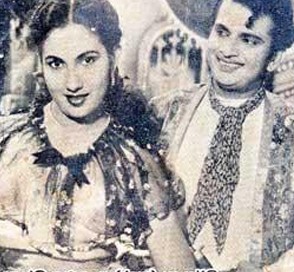
Surasena (1957) – Kanthi Gunatunga and Herbie Seneviratne
On Malai Kallan’s Sinhala re-make named ‘Surasena’ (1957)
From the limited information I could gather in the net, the Sinhala re-make ‘Surasena’ of Malai Kallan was released on Dec 13, 1957. It was only one of 8 movies released in that year. But, there appears to be quite a few discrepancies. All the songs were set to music, from the Hindi version that was tuned by C. Ramchandra. But, the notices state music director as Subbiah Naidu! The ‘Aplam Chaplam Chai Laiteri Duniya’ duet of the Hindi version was sung by as a duet by K. Jamunarani and K. Rani. Unusually, Padmini and Lalitha are listed for the dancing roles of Sayee and Subbulakshmi. But, without checking the title credit of the ‘Surasena’, I cannot confirm this. It’s rather difficult to fathom why Padmini and Lalitha (both very busy artistes in the Indian movies of 1950s) were hired as dancers for the Sinhala version, but not considered for the Tamil, Telugu, Hindi, Kannada and Malayalam versions. Could this be a clerical error of mis-identity? The lyricist credited was Ananda Samarakoon (1911-1962). Unfortunately, I couldn’t watch any video clips of the songs for Surasena movie.
Coda
David Robinson (b. 1930), British film critic and biographer of Chaplin, wrote the following perspective inference in the preface to his ‘The History of World Cinema’ (1973):
“The cinema involves an aesthetic, a technology, an economy and an audience; and all four of these elements will condition what moving images appear upon the screen at any particular place and in any period’. It is fairly pointless to write about cinema history only in terms of aesthetic judgment, simply to apportion praise or blame for artistic achievement or failure. It is true that in the end what will count is the dominating artistic personality of the author of any film (and though mostly we take the director to be the author, at times, the writer, the actor, the producer, the designer or the cameraman may also claim that role).”
As for the ‘Malai Kallan’ movie, the producer and director was Sriramulu Naidu. The writer’s credit has to be split equally between poet Namakkal Ramalingam Pillai (novel) and Karunanidhi (movie script). Though almost a dozen lead players collaborated to make the movie, the burden was on MGR, and it was his performance that captured the theater audience – the fourth element in Robinson’s criteria of movie magic.
What Robinson correctly pointed out in 1973 that, ‘The Indian cinema with its vast and on the whole indifferent annual output remains (perhaps understandably unexplored in the west’, still remains the same. This fact explains why ‘Malai Kallan’ is NOT listed among the top 100 movies listing, generated in the surveys of film experts.
Acknowledgment
I acknowledge the help rendered by my friend Arul M. Pandian, in deciphering the meanings of the Telugu and Hindi versions of the lyrics cited in this essay.
Sources
Eric Barnouw and S. Krishnaswamy: Indian Film, 2nd ed., Oxford University Press, New York, 1980, p. 176.
Rajesh Govindarajulu: The movie moghul from Coimbatore. The Hindu (Chennai), Nov 13, 2015.
Randor Guy: Blast from the Past series – Malaikallan (1954). The Hindu (Chennai), Apr 3, 2011.
M.S.S. Pandian: The Image Trap – M.G. Ramachandran in film and politics, SAGE Publications, New Delhi 1992.
A.S. Panneerselvan: Karunanidhi – A Life, Penguin Random House India Pvt Ltd, Gurgaon, Haryana, 2021, p. 83.
Ashish Rajadhyaksha and Paul Willemen: Encyclopedia of Indian Cinema, Oxford University Press, New Delhi 1999 revised ed., p. 336.
David Robinson: The History of World Cinema, Stein and Day Publishers, New York, 1973.
Pon Sellamuthu (ed): Tanjai Ramaiah Das Thirai Isai Paadalgal, part 1, Manivasagar Pathippagam, Chennai, 2012, pp. 319-326.
- Sloan: The Wizard of Oz unmasked as the President. New York Times, Dec 25, 1990.
Sriram: From Malaikkallan to Azaad. Madras Heritage and Carnatic Music Blog, May 14, 2018 https://sriramv.com/2018/05/14/from-malai-kallan-to-azad/
Vamanan: Thirai Isai Kalanjium (combined five parts of ‘Thirai Isai Alaigal’ series), Manivasagar Pathippagam, Chennai, 2014, p. 462.
Vaasanthi: Cut-Outs, Caste and Cine Stars – The World of Tamil Politics, Penguin Books India Pvt. Ltd., New Delhi, 2006, pp. 65-66.
Additional information
This detail on producer S.M. Sriramulu Naidu, which I had collected and saved in my files was inadertently missed in the original composition of this essay. M. Allirajan’s report entitled ‘Reel-time nostalgia’ [The Hindu, Nov 17, 2003] provides the information that both MGR and Bhanumathi received a remuneration for ‘Malai Kallan’ movie ‘a princely sum of Rs. 20,000. Sriramulu Naidu’s son Dr. S. Srihari was interviewed for this report.
A clarification: MGR and Bhanumathi EACH received Rs.20,000.
Wow, what a detailed research on this movie, clearing out half-truths, mis-information, and outright lies, hats off to Dr. Sachi, this article is of quality of a professional science paper!
Of course, the song “எத்தனை காலம் தான் ஏமாற்றுவார் · சொந்த நாட்டிலே நம்ம நாட்டிலே” is a Paradigm shifting message sequence in the Tamil Movie.
The myth that M.K. built the image of MGR is also busted by the fact that he could not build an image for his own son!
Thanks again for this article which sets several records straight.